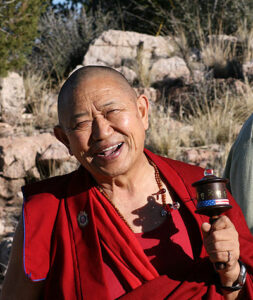The Period of Reform (1400-1615)
In the 15th century, the Ming Dynasty recognized the Drikungpa’s renewed and increasing influence and granted the throne holder the honorific title of Ch’an chiao wang that was conferred on the heads of the eight most important schools or monasteries. For two centuries Shigatse in the province of Tsang became the center of power in Tibet, first under the rulers of Rinpung (1436–1566), later under the Tsangpa (1566–1642). Since both noble families supported the Karmapa, the Karma Kagyu advanced to become the most influential school of the epoch.
Two outstanding personalities on the throne of Drikung left their marks in the beginning years of the 16th century: Gyalwang Kunga Rinchen (1475–1527) and his successor Gyalwang Rinchen Phuntsog (1509–1557). Kunga Rinchen was regarded as the reincarnation of Jigten Sumgön. He aspired to improve the quality of spiritual life. Kunga Rinchen dedicated himself intensively to giving transmissions and teachings, and he was also committed to reviving the tradition of retreats. Many of his new disciples, who were streaming to Drikung, were sent by him to do retreats at Mt. Kailash, Tsari and Lapchi. Under his direction, 50 new meditation huts were built at Drikung Thil Monastery. The Kangyur and Tengyur were copied on indigo paper in gold and silver script, while two hundred scribes were involved in the production of the complete texts of the Drikung lineage.
Rinchen Phuntsog, the 17th Drikung Denrab, was a great reformer. After receiving transmissions from various lineages, he integrated doctrines, rituals, and meditational practices above all of the Nyingma order into the traditional Drikung Kagyu teachings, thereby opening up and augmenting its dogmatic orientation. Rinchen Phuntsog discovered the treasure text Gongpa Yangzab in the Kiri Yangdzong Cave in the valley of Terdrom. Rinchen Phuntsog was an assiduous author whose writings are also highly regarded by the Nyingma, and were included in the collection of Nyingma tantras.
Rinchen Phuntsog’s only son, Chogyal Rinchen Phuntsog (1547–1602), was the 21st Denrab on the Drikung throne when Altan Khan (1507–1582), the powerful ruler of the Tumat Mongols, entered into an alliance with Sonam Gyatso (1543–1588) from the Gelugpa sect that was to influence the future course of Tibetan history decisively. The Mongolian ruler conferred the title of Dalai Lama on Sonam Gyatso and accorded him extensive privileges. Sonam Gyatso became the 3rd Dalai Lama because his two predecessors were given the title of Dalai Lama posthumously. As a result of many armed conflicts during the latter part of the 16th century, Chogyal Rinchen Phuntsog had the Drikung Dzong complex expanded into a fortress.
The first phase of succession to the highest office within the lineage ended with the sons of Chogyal Rinchen Phuntsog. His eldest son, Naro Tashi Phuntsog (1574–1628), called Naro Nyipa (“The second Naropa”), succeeded to the throne, while his younger son, Garwang Chökyi Wangchug (1584–1630), was recognized as the 6th Shamarpa. His two youngest sons, Gyalwang Konchog Rinchen (1590–1654) and Kunkhyen Rigzin Chödrak (1595–1659) became the last heirs to the throne of Drikung; the Kyura lineage died out with them. Upon the death of Konchog Rinchen the Drikungpa began to seek the reincarnations of their throne holders. A system of two lineage holders was established, that of the elder (Chetsang) and the younger (Chungtsang) brother. In the Drikung chronology Konchog Rinchen is considered as the first Chetsang and Rigzin Chödrak as the first Chungtsang. Both bear the title Drikung Kyabgon (‘bri gung skyabs mgon).
a
The description of the Glorious Drikung Kagyu Lineage is copied from the Drikung Kagyu Institute Website



